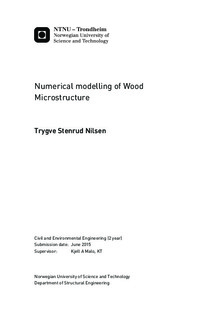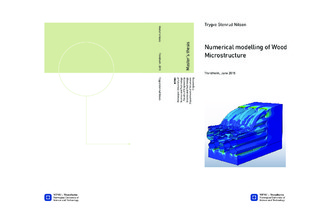| dc.description.abstract | The behaviour of wood is hard to predict due to the complex structure of the material. Wood consists of cells (fibres) arranged in an intricate pattern, and the behaviour of the material is a result of the behaviour of the cells and the cell arrangement. In this thesis, a new approach to numerical modelling of wood has been investigated, using the commercially available finite element program ABAQUS FEA. Instead of modelling wood with macroscopic properties and geometry, the cellular microstructure has been modelled. The cellular structure was modelled using shell elements, assigned the microscopic material properties of the cell walls and loaded with transverse compression.
An important point of the modelling process was to capture known physical effects that come into play in wood subjected to transverse compression. Especially the hammock effect and the effect of load distribution to the untouched areas of wood for increased stiffness and capacity needed to be included.
Due to the highly non-linear nature of the problem (buckling, material non-linearity and self-contact), an explicit dynamic formulation was used to analyse the problem. Modelling quasi-static problems with explicit dynamics requires the solution to be carefully controlled to ensure that the dynamic forces are insignificant so that the solution found is the quasi-static one. One way ensuring that dynamic forces are small compared to the static forces, is to look at the energy balance. If the kinetic energy and energy dissipated due to damping is significantly lower than the strain energy, the dynamic forces can be assumed insignificant.
In the results, load-deformation curves produced from the numerical simulations was presented and compared with load-deformation curves from previous lab experiments. The load-deformation curve of the numerical model resembled to some degree those of lab tests. Initially, the relationship between load and deformation was linear, and the linearity transitioned to a strain-hardening phase where the deformation increased and the load was close to constant. The hammock effect and load-distribution effect was seen clearly in the results, where the models with untouched wood on the side of the loaded area had higher stiffness and strength.
The results were plagued by a numerical instability phenomenon that occurred when the deformation was so large that many cells were completely caved in. This instability manifested itself through the load-deformation curve, which started out very smooth, but transitioned into a noisy and spiky curve towards the end. Numerical damping was applied to the model, which is seen in the energy balance. The energy dissipated due to numerical damping grew from a few percent to roughly 15% of the strain energy.
Design of small wood components, such as joints, requires a good material model in order to predict capacity and failure modes accurately. If developed further, microstructure modelling of wood can be a very helpful tool to predict the behaviour and capacity of wood components. | |

